Book contents
- Frontmatter
- Contents
- List of maps
- Preface
- Acknowledgments
- List of abbreviations
- Prologue
- Part I ALLIANCE
- Part II HEGEMONY
- Part III DOMINATION
- Chapter 14 Thebes, Delphi, and the outbreak of the Sacred War
- Chapter 15 Pammenes, the Persians, and the Sacred War
- Chapter 16 Philip II, the Greeks, and the King, 346–336 BC
- Chapter 17 A note on the battle of Chaeronea
- Chapter 18 Philip II's designs on Greece
- Epilogue
- Glossary
- References
- Index
Chapter 17 - A note on the battle of Chaeronea
from Part III - DOMINATION
Published online by Cambridge University Press: 22 September 2009
- Frontmatter
- Contents
- List of maps
- Preface
- Acknowledgments
- List of abbreviations
- Prologue
- Part I ALLIANCE
- Part II HEGEMONY
- Part III DOMINATION
- Chapter 14 Thebes, Delphi, and the outbreak of the Sacred War
- Chapter 15 Pammenes, the Persians, and the Sacred War
- Chapter 16 Philip II, the Greeks, and the King, 346–336 BC
- Chapter 17 A note on the battle of Chaeronea
- Chapter 18 Philip II's designs on Greece
- Epilogue
- Glossary
- References
- Index
Summary
Although the battle of Chaeronea was one of the truly decisive conflicts of Classical antiquity, surprisingly little is known of it, and that little has unfortunately and unnecessarily been embroidered by modern historians. This note aims to unravel some of that embroidery. Specifically, it argues against the prevalent view that at Chaeronea Alexander led a force of cavalry in a flanking attack against the Boeotians who stood opposite him. Diodorus, the principal source for the battle, depicts Alexander's actions at 16, 86, 3: After the engagement began, “Alexander, his heart set on showing his father his prowess and yielding to none in will to win, ably seconded by his men, first succeeded in rupturing the solid front of the enemy line. And striking down many, he bore heavily on the troops opposite him.” He thus states that Alexander broke the solid formation of the enemy with those who assisted him in the fighting. Plutarch (Alex. 9, 3) supports this aspect of Diodorus' testimony, and he further (Pel. 18, 7) corroborates it when he describes Philip's inspection of the slain Sacred Band after the battle. When Philip came to the place where the Thebans had fought and fallen, he remarked that they had bravely faced the sarisae of his army. Although the sarisa was sometimes used by light cavalry, the first use of it in this context cannot be dated earlier than Alexander's campaign at the Granicus River in 334.
- Type
- Chapter
- Information
- Publisher: Cambridge University PressPrint publication year: 2008



